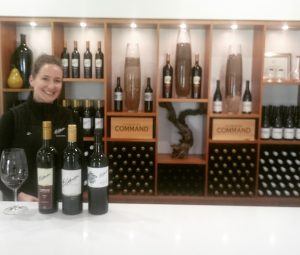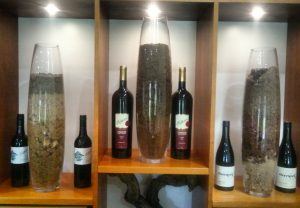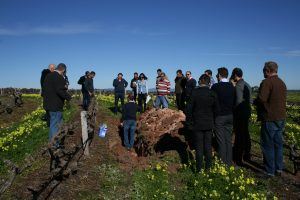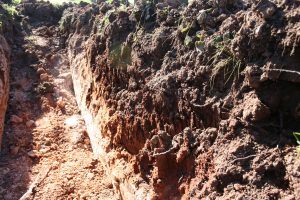
FAQs received in Cellar Door – part 2 – what difference does soil make?
We love having visitors in our Cellar Door from around the state, the country and the world. Each visitor has a different knowledge of wine, winemaking and viticulture. As such, we get some great questions from our visitors that allow us to provide insight into the influence that the environment and the vineyard can have on the finished product – our wines! We have picked some of the more frequently asked to share with you our thoughts. Over the coming months we will address these questions through the blog. If you have a question that you would like us to consider, please email jess@eldertonwines.com.au.
The question we address today is:
What difference does soil make?
In Cellar Door we have vases filled with soil on display.


This often prompts the question Why do you have vases filled with soil on the shelves?
The Ashmead family own three vineyard sites across the Barossa. The sites, at Greenock and Nuriootpa (Barossa Valley) and Craneford (Eden Valley) each have greatly varying soils. In Cellar Door we can talk about the differences and also have the soil samples to show the distinct nature of each vineyard site very clearly.
So what difference does soil make?
Soil contributes to what many know as ‘terroir’. Terroir is French and is difficult to translate but mostly relates to soils, topography and climate, the three which we will cover today. A great description of terroir is available to read on Halliday’s Wine Companion website, where Jess recently read this descriptive quote:
Bruno Prats, the former proprietor of Chateau Cos d’Estournel in the Medoc, explained it thus: “The very French notion of terroir looks at all the natural conditions which influence the biology of the vinestock and thus the composition of the grape itself. The terroir is the coming together of the climate, the soil, and the landscape. It is the combination of an infinite number of factors: temperatures by night and by day, rainfall distribution, hours of sunlight, slope and drainage, to name but a few. All these factors react with each other to form, in each part of the vineyard, what French wine growers call a terroir.”
Soil is therefore, just one part of the puzzle.
At the launch of our Greenock wines in 2013, we invited soil expert and co-author of The Soils of Southern South Australia David Maschmedt to talk about the soils of our Greenock vineyard. There is a lot of science!


The Barossa Grape & Wine Association has been working on a project for a number of years, looking to define the soils of the Barossa and what influence they may have over the aromas and flavours of the grapes grown throughout our region.
This is Barossa Grounds.
Nuriootpa, our home ground and Cellar Door base, is in ‘Area 7’ with deep, fertile alluvial soil as the vineyard is on the banks of the North Para River. Wines from this area tend to be full bodied and are seen as the classic Barossa style – structured, complex and concentrated.

The topography and climate are other parts to the puzzle. This plays a large role in the difference between wines from the Barossa Valley and the Eden Valley, which sits at a higher altitude. The lower lying Barossa Valley is generally warmer and drier, resulting in wines that are richer and deeper in flavour. The Eden Valley, at 400+ metres above sea level, is generally cooler and wetter and the soils have a tendency to be skeletal and minerally. The rolling hills also play a roll, with significant differences in vineyard aspect. As a result, wines from the Eden Valley tend to have greater acidity and are more elegant.
These differences can be seen in our Shiraz Terroir Tasting at Cellar Door, where we travel (figuratively speaking) to three areas of the Barossa, tasting wine from each of our Estate owned vineyards, and explore the diversity of Shiraz and the distinctive characteristics each vineyard brings to the wine.
If you would like any further information, please contact Jess.
